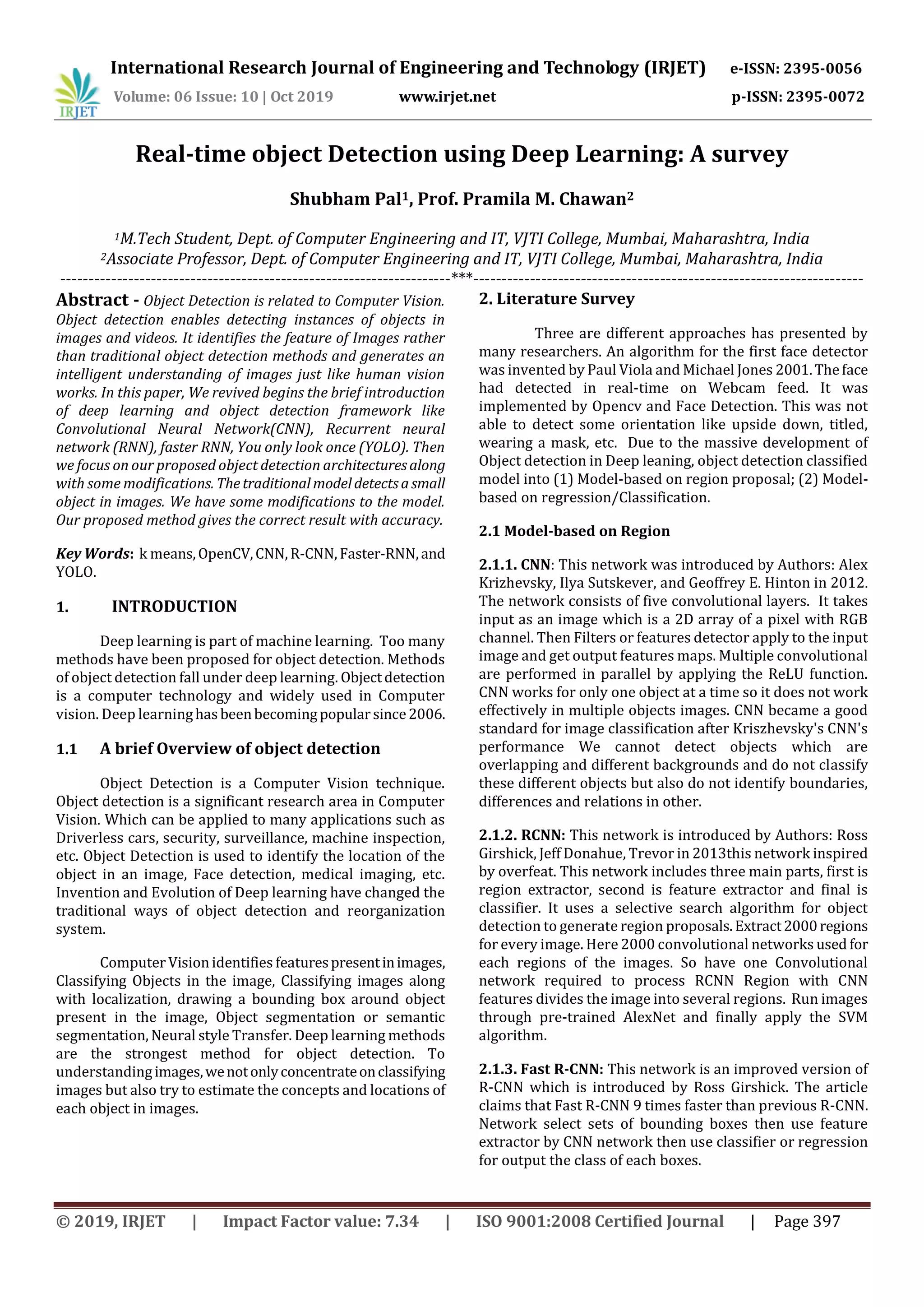This document summarizes recent advances in real-time object detection using deep learning. It first provides an overview of object detection and deep learning. It then reviews popular object detection models including CNNs, R-CNNs, Fast R-CNN, Faster R-CNN, YOLO, and SSD. The document proposes modifications to existing models to improve small object detection accuracy. Specifically, it proposes using Darknet-53 with feature map upsampling and concatenation at multiple scales to detect objects of different sizes. It also describes using k-means clustering to select anchor boxes tailored to each detection scale.


![International Research Journal of Engineering and Technology (IRJET) e-ISSN: 2395-0056 Volume: 06 Issue: 10 | Oct 2019 www.irjet.net p-ISSN: 2395-0072 © 2019, IRJET | Impact Factor value: 7.34 | ISO 9001:2008 Certified Journal | Page 399 Fig -1: Object Detection model 4. CONCLUSION This paper providesa detailedreviewofmanyofthe models in this paper related to object detection such as R- CNN, YOLO SSD, etc. Thenwehaveintroducedthelimitations of each technology. This proposed model focusonaccuracy than speed. The previous models are not accurate when images have small object Small object in images need to be detected. REFERENCES [1] The Object Detection Based on Deep Learning Cong Tang 1,2,3 , Yunsong Feng 1,2,3 , Xing Yang 1,2,3 , Chao Zheng 1,2,3 , Yuanpu Zhou 1,2,3 2017 4th International Conference on Information Science and Control Engineering [2] Moving object detection and tracking Using Convolutional Neural Networks Shraddha Mane Prof.Supriya Mangale Proceedings of the Second International Conference on Intelligent Computing and Control Systems (ICICCS 2018) IEEE Xplore Compliant PartNumber:CFP18K74-ART;ISBN:978-1-5386-2842-3 [3] Pedestrian Detection Based on YOLO Network Model Wenbo Lan ; Jianwu Dang ; Yangping Wang ; Song Wang 2018 IEEE International Conference on Mechatronics and Automation (ICMA) [4] Bones detection in the pelvic area on the basis of YOLO neural network Zuzanna Krawczyk ; Jacek Starzyński 19th International Conference Computational Problems of Electrical Engineering [5] Pedestrian Detection for Transformer SubstationBased on Gaussian Mixture Model and YOLO. 2016 8th International Conferenceon IntelligentHuman-Machine Systems and Cybernetics (IHMSC) [6] Faster R-CNN:TowardsReal-TimeObjectDetectionwith Region Proposal Networks Shaoqing Ren, Kaiming He, Ross Girshick, Jian Sun [7] You Only Look Once: Unified, Real-Time Object Detection Joseph Redmon, Santosh Divvala, Ross Girshick, Ali Farhadi in 2016 https://arxiv.org/abs/1506.02640](https://image.slidesharecdn.com/irjet-v6i1068-191226070609/75/IRJET-Real-Time-Object-Detection-using-Deep-Learning-A-Survey-3-2048.jpg)